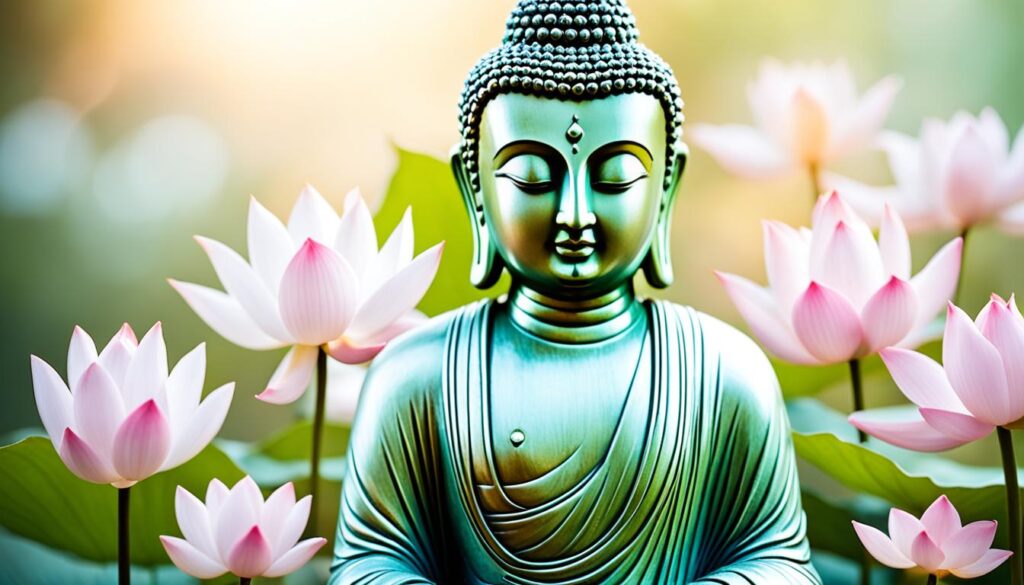Have you ever wondered how the language of Buddhism can contribute to your journey of inner peace and serenity? The translation of sacred Buddhist texts, the study of Buddhist terminology, and the exploration of its linguistic features offer profound insights into the teachings of Buddhism. Discover the power of Buddhist language in cultivating tranquility and finding fulfillment in your life.
Key Takeaways
- The translation of sacred Buddhist texts provides insights into the teachings of Buddhism.
- Studying the terminology of Buddhism deepens understanding and application of its principles.
- Buddhist language study explores the linguistic features and nuances of Buddhist texts.
- Investing in Buddhism translation services ensures accurate and authentic dissemination of Buddhist teachings.
- Embracing the serenity of Buddhism language enhances inner peace and fulfillment.
Understanding the Nature of Suffering
During his teachings, Buddha emphasized the nature of suffering, known as dukkha. He revealed that suffering arises from our desires and attachments to the ever-changing world around us. In today’s fast-paced world, characterized by constant stimulation and comparison, understanding the nature of suffering becomes vital in our pursuit of peace and serenity.
Suffering, or dukkha, is not limited to physical pain or hardships but encompasses the dissatisfaction and discontentment we experience when our desires are unmet or when we cling to temporary pleasures. It manifests in the restless pursuit of material possessions, fame, or societal approval, keeping us trapped in a cycle of craving and discontent.
In our modern society, driven by consumerism and the constant pursuit of personal gain, it’s easy to fall into the trap of always wanting more. We are bombarded with messages that fuel our desires and convince us that happiness lies in external accomplishments and possessions.
Pause for a moment and reflect on your own desires and attachments. How do they shape your experience of suffering in this fast-paced world?
To find true peace and serenity, Buddha taught that we must understand and acknowledge the impermanence and insubstantial nature of the objects of our desires. Recognizing that everything is subject to change and decay enables us to loosen our attachment and release the grip that suffering has on us.
Through cultivating awareness and mindfulness, we can observe our desires and attachments without judgment, gaining insight into their transient and unsatisfying nature. This newfound awareness empowers us to make conscious choices and shift our focus from external pursuits to nourishing our internal well-being.
| Common Desires | Effects on Inner Peace |
|---|---|
| Material possessions | Temporary fulfillment, followed by emptiness |
| Social validation | Dependence on external approval for self-worth |
| Comparison and envy | Feelings of inadequacy and perpetual dissatisfaction |
| Attachments to relationships | Fear of loss and emotional turbulence |
Understanding the nature of suffering liberates us from the relentless pursuit of unattainable happiness through external means. It invites us to embrace the present moment, cultivate gratitude for what we have, and prioritize our internal richness over fleeting desires.
Take a mindful breath, and consider how releasing your attachments and desires could lead to greater peace and serenity in your life.
The Path to Peace – The Eightfold Path
Central to Buddha’s teachings is the Eightfold Path, which serves as a practical guide to ethical living and mindful awareness. The path encompasses principles such as right understanding, intention, speech, action, livelihood, effort, mindfulness, and concentration. By following these principles, individuals can navigate life’s challenges with wisdom and compassion, ultimately leading to a state of peace.
Principles of the Eightfold Path
The Eightfold Path consists of interconnected principles that can be practiced and developed simultaneously. Each principle contributes to the cultivation of a peaceful and harmonious way of life. Let’s explore these principles:
- Right Understanding: Develop a deep understanding of the nature of reality and the impermanence of all phenomena. Through wisdom, gain insight into the causes of suffering and liberation.
- Right Intention: Cultivate wholesome intentions and aspirations, embracing compassion, goodwill, and non-harming towards oneself and others. Let go of intentions driven by greed, hatred, and delusion.
- Right Speech: Use words that are truthful, kind, beneficial, and timely. Refrain from speech that is divisive, harsh, idle, or dishonest.
- Right Action: Engage in actions that promote harmony, well-being, and non-violence. Avoid actions that cause harm to oneself and others, such as killing, stealing, and harmful sexual conduct.
- Right Livelihood: Earn a living in a way that is ethical, honorable, and supports the welfare of oneself and others. Refrain from engaging in trades that cause harm or exploit others.
- Right Effort: Cultivate wholesome qualities and abandon unwholesome ones. Make diligent effort to overcome negative habits and develop positive ones.
- Right Mindfulness: Cultivate present-moment awareness and non-judgmental observation of body, feelings, mind, and phenomena. Develop a heightened awareness of the interdependent nature of all things.
- Right Concentration: Cultivate focused and collected mind through various meditative practices. Develop deep states of concentration that lead to clarity, insight, and liberation.
By walking the Eightfold Path, individuals discover a profound transformation within themselves. This transformative journey fosters the development of mindfulness, ethical living, wisdom, compassion, and ultimately, the attainment of peace. The Eightfold Path provides a roadmap for aligning one’s thoughts, speech, and actions with the principles of Buddhism, allowing individuals to navigate the complexities of life with greater equanimity and serenity.

Mindfulness and Meditation
Mindfulness and meditation are integral components of Buddhist practice. Through the practice of mindfulness, individuals cultivate a state of mindful awareness, where they become fully present in the present moment, observing their thoughts and emotions without judgment or attachment. This heightened state of awareness allows for a profound sense of calmness and clarity to arise.
In today’s fast-paced world, distractions are abundant. The constant barrage of notifications, obligations, and responsibilities can easily overwhelm our minds, leading to stress and anxiety. However, by incorporating mindfulness and meditation into our daily lives, we create a sanctuary of peace amidst the chaos.
Imagine taking a few moments each day to sit in stillness, focusing on your breath and grounding yourself in the present moment. As you engage in this practice, you can gently nudge away the distractions that pull you away from the present. By redirecting your attention inward, you can cultivate a sense of calmness and clarity.
The Power of Mindfulness
Mindfulness allows us to observe our thoughts and emotions without becoming entangled in them. It helps us develop a non-reactive and non-judgmental attitude towards our experiences. By learning to let go of thoughts and emotions, we can create space for clarity and insight to arise.
With regular practice, mindfulness deepens our understanding of ourselves and our inner world. We become more attuned to our body, thoughts, and feelings, allowing us to navigate life’s challenges with greater ease and awareness.
Mindfulness also helps us cultivate compassion towards ourselves and others. As we become more present, we develop an open-heartedness that embraces the interconnectedness and unity of all beings.
The Transformative Practice of Meditation
Meditation is a powerful tool for cultivating mindful awareness and tranquility. By setting aside dedicated time for meditation, we create a space for stillness and self-reflection.
During meditation, we focus our attention on a specific object of awareness, such as the breath, a mantra, or a visual image. By anchoring our attention to this focal point, we train our minds to be less swayed by distractions, enhancing our ability to stay present and centered.
Over time, the practice of meditation deepens our concentration and insight. We gain clarity and understanding that extends beyond our meditation cushion into our everyday lives. It becomes easier to discern what truly matters, helping us make conscious choices that align with our values and aspirations.
To experience the transformative power of mindfulness and meditation, it’s important to establish a regular practice. Start with just a few minutes each day and gradually increase the duration. As you commit to this practice, you’ll discover the profound impact it has on your overall well-being and inner peace.

Navigate through the distractions of life with the empowering practice of mindfulness and meditation. Embrace the serenity, calmness, and clarity that arise from observing the present moment with non-judgmental awareness. Make space for tranquility in your daily life and experience the transformative power of mindfulness and meditation.
Compassion and Kindness
Buddha emphasized the importance of cultivating compassion and loving-kindness in your life. By embracing compassion, you can bring about positive change and create ripples of peace in your surroundings. The practice of loving-kindness, also known as metta, involves extending goodwill and kindness to yourself and others, fostering unity and harmony.
Compassion is the ability to empathize with the suffering of others and take action to alleviate it. When you cultivate compassion, you develop a deep understanding and empathy for the struggles that people face. This understanding compels you to seek ways to help and support others, promoting unity and a sense of shared humanity.
Kindness goes hand in hand with compassion. It involves acts of goodwill, generosity, and consideration towards others. When you practice kindness, you create an atmosphere of positivity and warmth. Small acts of kindness can have a profound impact on others, bringing joy and comfort to their lives.
Through compassion and loving-kindness, you can bridge gaps and break down barriers that often divide people. By embracing these qualities, you contribute to the creation of a harmonious and inclusive society, where individuals come together to support and uplift one another.
Benefits of Compassion and Kindness
Cultivating compassion and practicing kindness can have numerous benefits for both your inner well-being and your relationships with others. Some of these benefits include:
- Enhanced emotional well-being
- Reduced stress and anxiety
- Improved relationships
- Increased happiness and contentment
- Greater sense of purpose and fulfillment
When you radiate compassion and kindness, you create a positive ripple effect that extends far beyond yourself. Your actions inspire others to act with compassion and kindness, creating a chain reaction of love and unity in the world.
Embrace compassion and kindness in your daily life, and experience the transformative power they hold.

Detachment and Letting Go
In the journey towards inner serenity and peace, Buddhism teaches us the transformative power of detachment and letting go. Contrary to popular belief, detachment does not mean indifference or apathy; rather, it calls for liberating ourselves from the attachment to outcomes, possessions, and even our own beliefs.
By embracing the practice of non-attachment, we free ourselves from the burden of expectations and the constant pursuit of acquiring more. We learn to appreciate the present moment and find contentment in what we already have, rather than constantly yearning for what is beyond our grasp. Letting go of the desire for more possessions enables us to prioritize experiences, relationships, and personal growth.
Letting go also allows us to break free from the chains of the past and the anxiety of the future. It empowers us to release regrets, grudges, and worries, and instead cultivate a sense of acceptance and peace within ourselves. By detaching from the past and the future, we can fully embrace the present moment and find solace in its simplicity.

Embracing the Present Moment
One powerful way to practice detachment and let go is through mindfulness meditation. By focusing our attention on the present moment, we train ourselves to observe our thoughts, emotions, and sensations without judgment or attachment. This awareness allows us to cultivate a state of calm and equanimity, even in the midst of chaos.
- Begin by finding a quiet and comfortable space where you can sit or lie down.
- Close your eyes and take a few deep breaths, allowing yourself to relax.
- Shift your attention to the sensations in your body, noticing any areas of tension or discomfort.
- As thoughts arise, acknowledge them without judgment and gently guide your focus back to your breath.
- Allow yourself to fully experience each breath, moment by moment, without clinging to any particular sensation.
- If your mind wanders, gently redirect your focus back to your breath and the present moment.
- Continue this practice for a few minutes each day, gradually increasing the duration as you become more comfortable.
As you cultivate the practice of detachment and letting go, you will discover a newfound sense of freedom and peace. By releasing attachment to outcomes, possessions, and beliefs, you create space for joy, compassion, and serenity to thrive in your life. Embracing the present moment becomes a gateway to inner contentment and fulfillment, allowing you to live with greater authenticity and gratitude.
Conclusion
Buddha’s teachings offer a profound framework for individuals seeking inner serenity and peace in the midst of life’s chaotic nature. By delving into the nature of suffering, following the path of the Eightfold Path, practicing mindfulness and compassion, embracing detachment and change, one can cultivate a profound sense of inner calm and lead a more fulfilling existence.
Through the understanding of suffering, individuals can identify the root causes of their own pain and dissatisfaction. By addressing these causes and cultivating a deep sense of compassion and kindness towards oneself and others, a transformative journey towards peace and serenity begins. Mindfulness and meditation play a crucial role, allowing individuals to cultivate present-moment awareness and detach from the constant distractions of the modern world, creating a space for inner clarity and calmness.
By integrating the principles of the Eightfold Path into everyday life, individuals can develop ethical living, wisdom, and compassion. The path acts as a guide to navigate life’s challenges with integrity and mindfulness. Additionally, embracing the practice of detachment and letting go of attachments to outcomes, possessions, and beliefs enables individuals to appreciate the present moment and find joy in the simple pleasures of life.
Ultimately, Buddhism offers a pathway to inner serenity and peace. By actively engaging with the teachings, individuals can embark on a journey of self-discovery, leading to a more peaceful and fulfilling existence. May your exploration of Buddhism’s profound wisdom bring you the tranquility and serenity you seek.
FAQ
How can exploring the language of Buddhism help me find inner peace and serenity?
By delving into the language of Buddhism, including its translation, sacred texts, terminology, and linguistic features, you can gain deeper insights into the teachings of Buddhism. This understanding can be a source of profound wisdom and guidance on finding inner peace and serenity in your life.
What is the nature of suffering according to Buddhism?
Buddhism teaches that suffering, known as dukkha, arises from desire and attachment. In a fast-paced world where desires are constantly fueled and comparison is rampant, understanding the nature of suffering becomes crucial in finding peace and serenity.
What is the Eightfold Path and how does it lead to peace?
The Eightfold Path is a central teaching of Buddhism that serves as a practical guide to ethical living and mindful awareness. It encompasses principles such as right understanding, intention, speech, action, livelihood, effort, mindfulness, and concentration. By following these principles, individuals can navigate life’s challenges with wisdom and compassion, ultimately leading to a state of peace.
How can mindfulness and meditation contribute to inner calm?
Mindfulness and meditation are integral components of Buddhist practice. With mindfulness, individuals learn to observe their thoughts and emotions without attachment, leading to a profound sense of calmness and clarity. In today’s world, where distractions are omnipresent, the practice of mindfulness and meditation can act as a sanctuary of peace.
How does compassion and kindness relate to Buddhism and finding peace?
Buddha emphasized the importance of cultivating compassion and loving-kindness towards oneself and others. By practicing compassion, individuals can create ripples of peace in their surroundings, bridging gaps and fostering a sense of unity and harmony in a world often divided by differences.
What is the significance of detachment and letting go in Buddhism?
In Buddhism, detachment does not mean becoming indifferent. It involves letting go of attachment to outcomes, possessions, and beliefs. Learning to appreciate the present moment and letting go of the constant demands for more can be a source of great peace and serenity.

